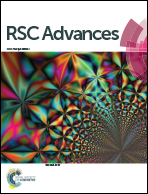Electromagnetic interference shielding properties of solid-state polymerization conducting polymer†
Abstract
Poly(3,4-ethylenedioxythiophene) (PEDOT) has been synthesized through a facile solid-state polymerization (SSP) approach. The polymerization was simply initiated by sintering the monomer, 2,5-dibro-3,4-ethylenedioxythiophene (DBEDOT), at a temperature of 80 °C. A high performance shield for electromagnetic interference (EMI) protection based on this SSP-PEDOT has been developed. The SSP-PEDOT with a heating time of 24 hours has the maximum value of the dielectric loss tangent (tan δε) in the frequency range of 2–18 GHz, which revealed that this sample has the best electromagnetic energy absorption ability. When the thickness of the sample reached 2 mm, the bandwidth with the reflection loss (RL) deeper than −10 dB was nearly 5.9 GHz (from 10.0 GHz to 15.9 GHz), and the maximum value of RL was about −50.1 dB at 11.2 GHz. The SSP-PEDOT with a heating time of 1 hour had the best EMI shielding effectiveness (SEtotal) in the entire frequency range of 2–18 GHz, which was almost contributed to the reflection from the material surface (SER). These results demonstrated that SSP initiated at low temperature shows multi-practical EMI shielding application in the areas of military camouflage and electronic devices protection.


 Please wait while we load your content...
Please wait while we load your content...